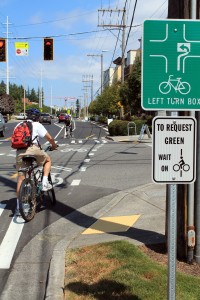Seattle is taking another stab at improving bicycling in the city in an updated Bicycle Master Plan that relies heavily on cycle tracks and greenways — two schemes not promoted in the original master plan approved in 2007.
The idea is to entice potential bike riders who are not particularly interested in mixing it up with traffic on bike lanes or shared-used roads.
The authors of the latest Bicycle Master Plan want to encourage more people to use bicycles for commuting and errand-running by creating enjoyable and safe places to ride. Cycle tracks, neighborhood greenways and bike trails fit the bill.
The Seattle City Council endorsed the updated 20-year Master Plan this week.
New modes
Trails speak for themselves and have been around for years. The idea of cycle tracks — one- or two-way bicycle lanes that are physically separated from traffic — became popular in recent years among bike advocates who see them in use in Europe. Greenways are residential streets designed for low traffic volume and speeds.
Both are currently in use in Seattle on a limited bases. Linden Avenue had the first cycle track that connected segments of the Interurban Trail. There are 3.2 miles of cycle track in place in the city; the master plan calls for building a total 101 miles of new or upgraded cycle track.
About 10 miles of Seattle’s neighborhood streets are considered as greenways; the plan calls for creating 238 miles of greenways through neighborhoods.
The plan also calls for adding another 32 miles to the city’s network of 47 miles of bike trails.
At one time, the miles of bike lanes in a city were a measure of its bike-worthiness. The new master plan calls for building or upgrading 93 miles of bike lanes for a total 137 miles of bike lanes in the city, less than a quarter of the future 608-mile bicycle network for Seattle.
Total cost for all this work ranges from $391 million to $524 million. The cycle tracks are the most expensive project for bicycles, costing between $1.5 million to $1.9 million per mile. Bike paths are slightly less costly at $1.4 million to $1.5 million per mile. Greenways cost about $650,000 per mile.
The previous Bicycle Master Plan approved in 2007 set out to spend about $240 million over 10 years to build bike lanes, bike trails and signed bike routes around the city.
You can find the Adopted Bicycle Master Plan and supporting documents at the Seattle Department of Transportation website. It’s really a nice looking document with lots of details.
Also, Seattle Bike Blog writes on how to fulfill the vision in the updated master plan.
Seattle Times also covered the revamped master plan.



1 pings
[…] Seattle is taking another stab at improving bicycling in the city in an updated Bicycle Master Plan that relies heavily on cycle tracks and greenways — two schemes not promoted in the original master plan approved in 2007.The authors of the latest Bicycle Master Plan want to encourage more people to use bicycles for commuting and errand-running by creating enjoyable and safe places to ride. Cycle tracks, neighborhood greenways and bike trails fit the bill.Trails speak for themselves and have been around for years. The idea of cycle tracks — one- or two-way bicycle lanes that are physically separated from traffic — became popular in recent years among bike advocates who see them in use in Europe. Greenways are residential streets designed for low traffic volume and speeds. Read full article […]